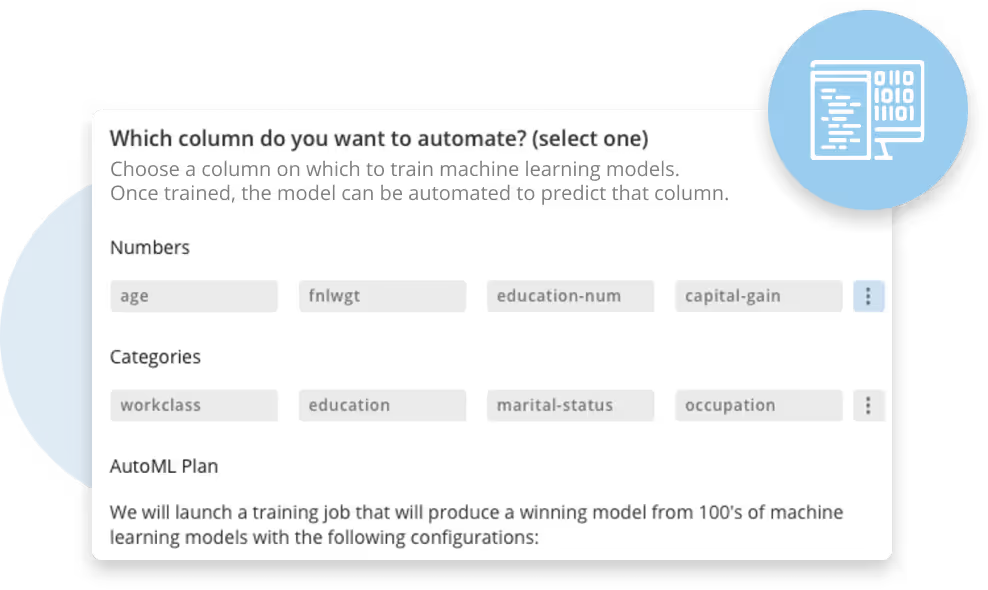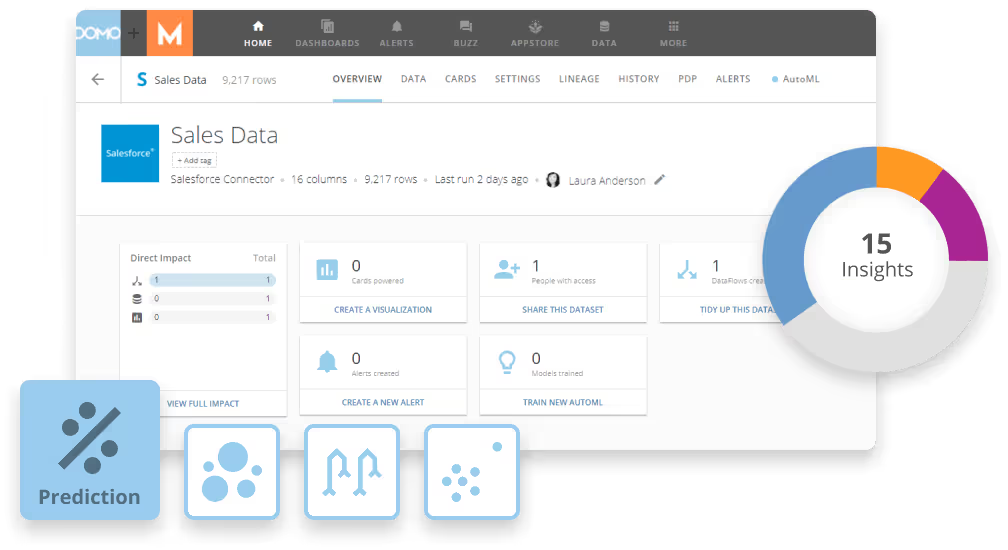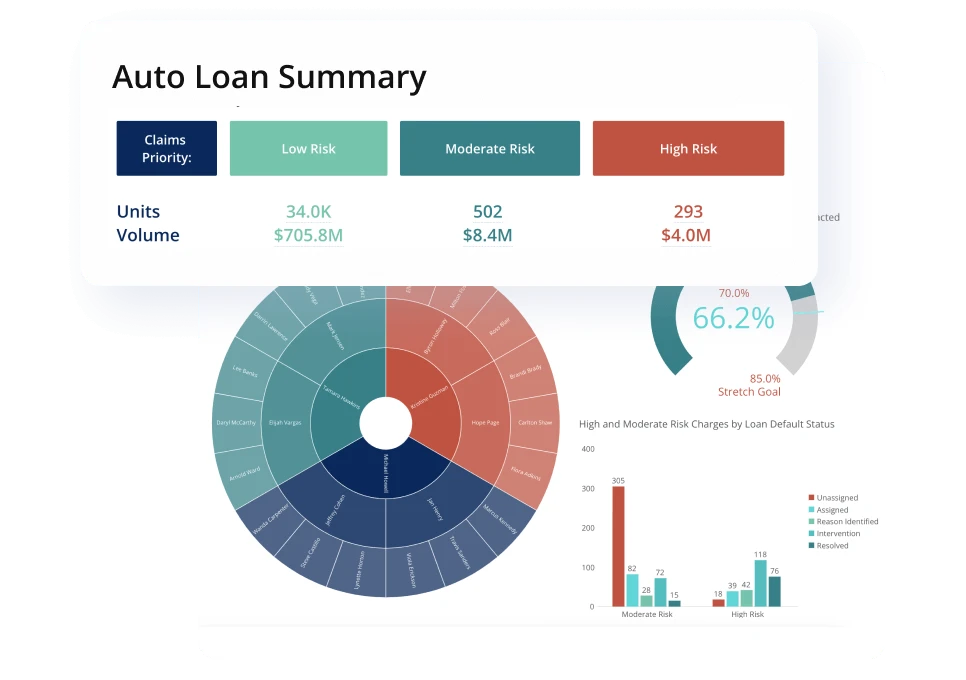Data Science and Machine Learning
End-to-end tools to productionize AI and data science.
Domo's full-stack, data experience platform allows you to connect and transform data, build data science models, and visualize results so you can optimize your data science pipelines.

Automate data science workflows.
Develop, productionize, monitor, and visualize your models in one secure system.
Manage your models.
Create and deploy AI/ML models and monitor performance and drift, setting alerts for flagged performance so you know when something changes.
Enable rapid decision-making.
Provide your teams, customers, and partners with real-time, AI-powered insights to help drive data-driven business impact.
Leverage AI while minimizing risk.
With Domo.AI you can give users AI-powered data experiences that use ChatGPT and other public models without sacrificing flexibility or security. Manage, deploy, and optimize AI and ML models, including Large Language Models (LLMs). Control who can build AI models, enable AI services, and use service endpoints. Replace the patchwork of tools and platforms, and let users take advantage of the power of AI with confidence and ease.

Manage data pipelines seamlessly.
Data science models require data to adhere to a specific schema, with processes that need to be fully managed in the data pipeline. With Domo, you can prepare, transform, and clean your data to discover insights at scale, enabling analytics to kickstart exploration and produce results.

Implement ModelOps.
Domo allows you to reduce manual effort and streamline the deployment and maintenance of ML models. Data is flagged when attributes deviate from data types, structures, and values that are required to make accurate inferences.

Detect model drift.
Access automated information about how models are performing in production so you can tell if incoming input data has drifted. Ensure that your models remain accurate and that they perform as designed for accurate and reliable predictions.

Collaborate in the platform.
Use Domo’s built-in collaboration tools to share insights on data, flag any issues, and communicate with stakeholders. Share datasets with colleagues, annotate charts, and leave comments and notes right on a visualization.

Engage technical and end users.
Domo provides both data scientists and business users with the insights they need. Data scientists get the power of Domo charts and dashboards to evaluate how models are performing. At the same time, they can create easy-to-use business-facing dashboards that provide the insights end users are asking for.

Create and deploy models with Jupyter.
No matter your use case, Domo’s seamless integration with Jupyter ensures that you can use the tools you’re familiar with to develop machine learning (ML) models and then produce relevant insights available to business users. With Jupyter Workspaces, you can:

Use familiar languages.
Develop and run data science models and programmatic applications in either R or Python.
Optimize Jupyter.
Integrate your Jupyter-based work with the Domo platform for visualization, action-based alerting, model operations, and more.
Integrate with dev tools.
Integrate with Github for model management.
Collaborate with others.
Use Juptyer workspaces for collaborative projects involving multiple users and contributors.
Manage workflows.
Prepare your data, engineer your features, train and compare models, and automate production models via scheduling.
Deliver insights.
Create easy-to-understand dashboards based on ML insights for business users and executives.
Accelerate model development with AutoML.
AutoML helps you move from data to models to outcomes faster. Integrated with Amazon Sagemaker Autopilot, Domo’s AutoML accelerates model development and makes it possible to share machine learning insights with your teams via visualizations and data apps.
Connect and transform data from any source.
Automatically train hundreds of machine learning models.
Convert models into new data pipelines.

Professional services to boost your team.
Domo’s Data Science Professional Services Team enables you to build data science pipelines for your organization via hands-on training in machine learning, data science research and development, and consulting services.
Create a customized data science roadmap and then convert that roadmap into actionable data science processes and practices.
Engage with Domo’s data science professional educators to provide training for your team.
Work with Domo’s data science experts to build custom, fully automated data science solutions for your business.

Sample use cases.
Here are just a few ways you can use Domo’s data science tools. If you don’t see what you’re looking for here, contact us to discuss your specific use case.

Predict employee turnover.
Use predictive analytics to gain insight into which employees will terminate their employment.
- Estimate the total number of months that an employee will work for the company.
- Understand the risk level of termination, considering management succession, last bonus, last base pay increase, total pay, and more.
- Intervene earlier to retain valuable employees.

Calculate engagement scores.
Assess customers’ engagement with your business to make better customer decisions.
- Select criteria to use for calculating engagement scores, such as purchase history, webstore usage, and payment behavior.
- Segment customers and personalize customer interactions based on engagement scores.
- Drive retention and upsell activities based on customer engagement.

Predict loan default.
Protect your business by predicting which loans are most likely to default.
- Choose data points to build a model that predicts which loans are potentially worrisome, using data such as number of months where loans are past due, credit score, and loan payoff balance.
- Arm customer service teams with information to intervene in high-risk scenarios, before it’s too late.
- Reduce the number of loans that go into default.

Align inventory to demand.
Understand how much inventory your business needs to fulfill future customer orders.
- Use forecasting to predict orders in future periods and adjust inventory levels accordingly, so you can meet customer demand while not carrying extra inventory.
- Leverage historical data and assumptions about the market and company performance to predict future customer ordering trends.
- Set alerts to notify your company when adjustments to inventory are needed based on your forecasting results.

Perform sentiment analysis.
Quickly understand how customers feel about your product or business by analyzing text data from online reviews, emails, social media, and more.
- Decipher the emotional tone of a given text using a Natural Language Processing (NLP) algorithm and classify the text as positive, negative, or neutral.
- Identify which words or topics are commonly mentioned in your text data.
- Leverage insights to refine product offerings, improve customer service, increase brand reputation, and boost company performance.

Understand propensity to pay.
Reduce time spent trying to collect on unpaid accounts.
- Identify underlying factors that contribute to whether a customer pays for an account.
- Provide teams with enough lead time to allow identification and preemptive resolution of billing issues.
- Use additional analytics for more accurate revenue forecasting.
Putting your data to work
Explore the data experiences that trigger better, faster decisions across every team and function.
Visualizations & Dashboards
Create interactive, easy-to-use visualizations that support "Aha!" moments.
Reporting & Self-Service Analytics
Modernize your reporting with real-time data that everyone can self-serve.
Business Apps
Build low- or pro-code apps that improve operational processes.
Embedded Analytics
Securely share data and insights outside your organization.
Domo.AI
Deliver actionable data experiences that scale with an AI framework you can trust.
Get started.
Tools and resources to take action now.
